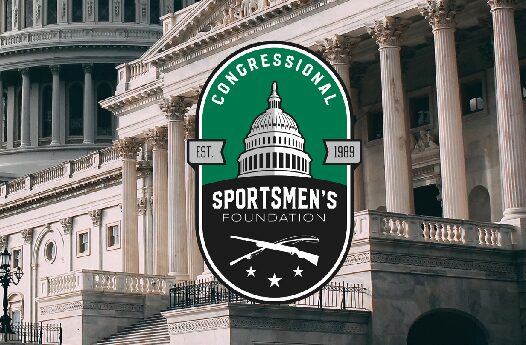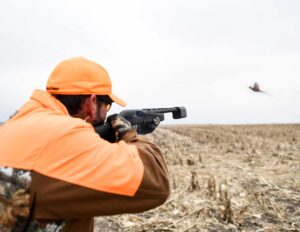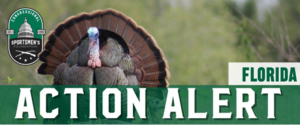Policy Corner Brief: NOVEMBER 2024

HUNTING IN THE SOUTHEAST HAS MANY PERKS: PROTECTING YOUR HEARING IS ONE OF THEM
ARTICLE CONTACT: CONNER BARKER
Why It Matters: As hunters of all ages begin or continue their outdoor adventures, ensuring they have a safe and enjoyable experience is critical to hunter recruitment, retention, and reactivation (R3) efforts. Whether it is guidance on how to properly handle a firearm or how to safely ascend a tree stand, hunter safety takes many forms. Education surrounding hearing protection while afield is often overlooked by many hunters. However, proper education on how to protect your hearing while pursuing your favorite game species can ensure hunters have a pleasurable experience afield, thus potentially strengthening hunter participation and R3 efforts.
Highlights:
- According to our partners at the American Suppressor Association (ASA), hunters and recreational shooters are among the groups that face the most serious threats to hearing loss.
- Firearm suppressors mitigate the sound signature of a firearm, often reducing the noise from a gunshot by 20 – 35 decibels.
- Currently, all Southeastern states permit the use of firearm suppressors for hunting.
Hunting seasons are in full swing across the Southeast and in most of the country. As you gear up to head afield after your species of choice, you may have a long checklist of items to grab before heading out the door. Unfortunately, many hunters neglect, overlook, or choose not to wear hearing protection to maintain situational awareness while in the field. When most folks think of hearing protection, they picture a traditional set of headphones or earplugs. However, as firearm suppressors have grown in popularity, they offer a safe and effective means of hearing protection while afield not only for the hunter, but also for hunting dogs and others in close proximity.
With processing times down to historic lows and hunting with suppressors now permitted in all Southeastern states, now is an excellent time for hunters to take hearing protection to a new level while afield. In addition to hearing protection, suppressors also reduce recoil and muzzle rise which leads to a more consistent shot and overall positive experience for new hunters, potentially contributing to hunter recruitment efforts. On the other hand, older generations of hunters that have suffered hearing loss due to repeated exposure to gun fire while afield now have access to a safe alternative for hearing protection. Regardless of the demographic of hunter, suppressors provide a safe option for hearing protection while participating in our time-honored traditions.
With the growing popularity of suppressors, the Southeast is not alone in allowing hunters to utilize suppressors for hunting. Most recently, thanks to an effort spearheaded by the Vermont Legislative Sportsmen’s Caucus, hunting with suppressors was permanently authorized earlier this year, removing the two-year sunset provision previously in place.
Nationally, suppressor ownership is legal in 42 states and is legal for hunting in 41 states. The Congressional Sportsmen’s Foundation (CSF) will continue working alongside Legislative Sportsmen’s Caucuses across the country and our partners at ASA to advocate for suppressor ownership and their use for hunting.
YOUTH HUNTING SEASONS IN THE GREAT PLAINS
ARTICLE CONTACT: JAKE GOULD
Why It Matters: Many states in the Midwest and across the country offer opportunities for youth hunters to hit the field in pursuit of game species including deer, turkey, ducks, and pheasants before the seasons open to the public. States offering youth hunting seasons provide a great opportunity for young hunters to participate in our time-honored outdoor traditions in a less-crowded, and lower-pressure environment, while also giving them a great opportunity to learn from an experienced mentor.
Highlights
- Hunter Recruitment, Retention, and Reactivation, or R3, is a key element of ensuring a bright future for our sporting-conservation traditions, and youth hunting seasons provide a great opportunity to welcome new participants to hunting.
- Inviting prospective hunters to enter our community at a young age allows them to receive hands-on learning experiences that they can carry with them as they continue their hunting journey.
Many of the Great Plains States offer youth hunters the opportunity to hit the field before the seasons open to the public. Youth hunting seasons provide a great opportunity for kids to participate in a less crowded, and lower-pressure environment hunt. These hunting seasons are also a great opportunity for teaching the importance of safe and ethical hunting before they start hitting the woods as adults. Providing youth seasons can be an effective tool for recruiting new hunters and maintaining our sporting heritage.
In Iowa, the youth deer hunting season started September 21, allowing youth hunters to be in the field a week before the season opens for the early archery season. The Iowa Department of Natural Resources (DNR) has seen a great start to their youth deer hunting season with a higher-than-average number of harvested deer being registered.
Moving west to the Cornhusker State, the Nebraska Game and Parks Commission (NGPC) is offering a special youth hunt season for pheasants for hunters under the age of 15, allowing them the opportunity to hunt with a mentor in a controlled environment where roosters will be released. Having a successful hunt can be important to helping to keep youth hunters engaged and motivated to continue hunting as they get older.
The North Dakota Game and Fish Department (NDGF) also held their youth pheasant hunting weekend at the beginning of October, allowing hunters 15 and under to hunt under the guidance of a mentor. NDGF also offers a one-year apprentice hunter validation for hunters 12 and older. This allows youth hunters an opportunity to participate in the pheasant youth hunting weekend without needing to pass a hunter education course.
Youth hunting seasons for deer, turkey, ducks, or pheasants can be a great starting point for recruiting the next generation of sportsmen and women, leading to a life-long passion of outdoor sporting heritage. However, continued mentorship and multiple hunting experiences are pivotal for R3 efforts.
TAKE A KID HUNTING THIS FALL
ARTICLE CONTACT: FRED BIRD
Why It Matters: With fall hunting seasons in full swing, many state youth seasons are on the calendar with young hunters giddy with excitement. While many children who were born into generational traditions of hunting have quick access to exciting experiences in the field, there are others with a hunger and a passionate interest in hunting who lack such familial support. It is no secret hunting participation numbers are down. If our hunting heritage and our participation in the North American Model of Wildlife Conservation as well as the American System of Conservation Funding are going to survive, as the song goes, “I believe the children are our future.”
Highlights
- The percentage of U.S. citizens who hunt has been generally declining since 1982. In 2023, there were 15.92 million certified paid hunting license holders, resulting in an effective participation rate of 4.7% (down from 16.75 million hunters at 7.2% in 1982).
- In response to the declining number of sportsmen and women, state fish and wildlife agencies, conservation organizations, shooting sports organizations, and the hunting/shooting sports industry have invested heavily in recruitment, retention, and reactivation (R3) initiatives.
- Over 450 individual R3 programs nationwide have had limited regional success but haven’t sufficiently addressed the overall decline in hunter numbers.
The first R in R3 , recruitment, is the most basic idea and step the sporting community must take to ensure our traditions, management, and funding models continue to exist long after we have departed our Earthly constraints. While the R3 movement is not focused solely on youth hunters, it is our youth hunters who will carry on our traditions as they mature into contributing members and leaders in the sporting community. Youth hunting seasons present a great opportunity to bring young folks afield without the normal hunting pressure and presence of regularly licensed hunters. It creates more of a controlled environment for the budding sports-boys or girls to focus on developing their skillsets with a family member or mentor. If you find yourself in an empty nest situation or haven’t started a family of your own, if you can lend your years of experience to a young person, do it! Learn to hunt programs put on by state fish and wildlife agencies are a great place to start and volunteer.
If we are going to stem the tide of falling numbers in hunting participation, those of us with the means to mentor should be an active participant in the solution and not a passive onlooker. The Congressional Sportsmen’s Foundation (CSF) will continue to inform lawmakers about the importance of promoting hunting participation to ensure policies are in place to promote our traditions to future generations.
PENNSYLVANIA FISHING LICENSE FEE BILL IS HEADED TO GOVERNOR SHAPIRO’S DESK
ARTICLE CONTACT: KALEIGH LEAGER
Why It Matters: On Tuesday, October 22nd, the Pennsylvania State Senate voted 47-3 to send House Bill 1409 (HB 1409) to Governor Josh Shapiro’s desk. HB 1409 (sponsored by Legislative Sportsmen’s Caucus Member and Chair of the House Fish & Game Committee, Rep. Anita Astorino Kulik) extends the Pennsylvania Fish & Boat Commission’s (PFBC) Board of Commissioner’s authority to set its own license fees. Without the enactment of this legislation, the PFBC would have to relinquish its ability to set its own license fees back to the legislature due to a sunset provision in the originating statute. Allowing state agencies to set their own license fees provides the flexibility needed to adjust for inflation and properly manage the public resource in a timely and effective manner.
Highlights:
- HB 1409 passed out of the Pennsylvania House of Representatives on September 27, 2023, with a 154-48 vote and out of the Pennsylvania State Senate on October 22nd, 2024, with a 47-3 vote.
- The PFBC originally received the authority to set its own licenses fees from Act 56 of 2020 (spearheaded by members of the Pennsylvania Legislative Sportsmen’s Caucus) for 5 years (expiring on July 15, 2025).
- In necessity to extend this authority, the Congressional Sportsmen’s Foundation (CSF) submitted a letter of support for HB 1409, granting the PFBC’s fee setting authority until July 15, 2035 (an additional 10 years).
The first residential hunting license did not appear in the United States until 1895 when the state of Michigan issued a $0.50 license for deer hunting. From its success, many states followed suit, and, by the early 20th century, newly created state fish and wildlife agencies were issued licenses across the country. These licenses sold and enforced by state agencies are designed to generate funding for the state agency for the sustainable management of fish and wildlife, and their habitats.
Despite having jurisdiction over the fish and wildlife within the state, most state fish and wildlife agencies have little control over setting the prices for hunting and fishing licenses, permits and tags. Rather, the authority often rests with the state legislature, requiring new legislation each time the state agency needs to keep up with inflation. This process makes it difficult to increase license fees to ensure the agency maintains the pace of inflation and that they are adequately funded to continue managing fish and wildlife on behalf of the public. The legislative cycle is a complex system by design, but sometimes lacks the ability to act in a timely and effective manner.
Legislation such as HB 1409 is imperative for the PFBC as the agency receives no general fund monies and is funded by the sportsmen and women of the Commonwealth. When an agency such as the PFBC must wait for legislation to pass to increase license fees (which directly impacts their budget), they are at risk being unable to properly manage the resource due to the lack of available funds. When adequate funding is unavailable, the fish, their habitat, agency law enforcement, agency employees, and the public are all negatively impacted.
The Congressional Sportsmen’s Foundation applauds the legislature for passing this important legislation yet again and encourages Governor Josh Shapiro to quickly sign this legislation so there is not a lapse in fee setting authority with the PFBC’s Board of Commissioners. The Congressional Sportsmen’s Foundation will continue to work with the Pennsylvania Legislative Sportsmen’s Caucus, and the PFBC, like it has done historically, to secure the agency’s ability to set its own license fees.
States Involved: PA
ELECTION DAY IS HERE – VOTE YES ON AMENDMENT 2 IN FLORIDA
ARTICLE CONTACT: MARK LANCE
Why It Matters: Tomorrow, November 5, those who haven’t voted early or by mail will flock to the polls to have their voice heard on Election Day. As we have reported previously, Floridians can enshrine the right to hunt and fish within their state constitution by voting “yes” on Amendment 2. If Amendment 2 receives over 60% of the vote, Florida will join 23 other states in protecting the rights of hunters and anglers and science-based fish and wildlife management in Florida for generations to come.
Highlights:
- Amendment 2 protects the rights of hunters and anglers in perpetuity and ensures that hunting and fishing continue to be the preferred means of managing wildlife populations with harvestable surpluses.
- Amendment 2 does not affect the constitutional authority of the Florida Fish and Wildlife Conservation Commission (FWC) to set seasons, bag limits, etc., nor does it affect private property rights or legalize methods of take that are currently illegal.
- Amendment 2 also further protects the $70+ million in funding for conservation that hunters and anglers generate each year in Florida through the American System of Conservation Funding.
The anti-sportsmen community has come out in force opposing Amendment 2 and is spreading misinformation about its impact. Their unfounded claims have ranged from the total abolishment of private property rights, the legalization of gill nets, and basically an all-out free for all on harvesting wildlife in Florida – disregarding the power of the FWC. These claims were refuted at the latest FWC meeting, where Chairman Barreto clarified with their Chief Conservation Officer and General Counsel that Amendment 2 would not lift the net ban nor would it impact the authority of the FWC in any way. Despite the FWC setting the record straight, these anti-sportsmen organizations continue to lead efforts to persuade the public to believe that hunting, fishing, and harvesting wildlife are a privilege, subject to emotionally driven public sentiments to alter policies and regulations. Amendment 2 ensures that the time-honored sporting traditions of Floridians as well as the future of science-based wildlife management through the North American Model of Wildlife Conservation are protected for generations to come.
The Congressional Sportsmen’s Foundation (CSF) was proud to play a part in developing the language and coordinating with the FWC, the Florida Legislative Sportsmen’s Caucus, and so many other in-state and national partners to support Amendment 2. We encourage all Floridians to recognize the benefits that hunting and fishing have on wildlife conservation as well as the state and local economies and vote to protect our time-honored traditions for the foreseeable future. For more information on Amendment 2, please click here.
States Involved: FL
HUNTERS’ HARVEST: SHARING THE REWARDS OF OUR EFFORTS THIS SEASON
ARTICLE CONTACT: KENT KEENE
Why It Matters: With white-tailed deer hunters around the country already enjoying, or looking forward to the fast approaching, rut, now is an excellent time to celebrate the role of hunters as some of America’s most passionate conservationists. However, the contributions of sportsmen and sportswomen do not end with conservation funding and wildlife population management. With the holiday season approaching, game meat donation programs serve as an opportunity for hunters to share their harvest and provide yet another service to society.
Highlights:
- Donating hunter-harvested game meat such as venison is an effective way to distribute surplus meat to those in need when a hunter harvests more than they can eat themselves.
- In America, public perceptions of hunting remain positive when the procurement of meat is primary motivation for the harvest of wild game. Game meat donation programs help to educate others on this component of the sportsman ethic while sharing the benefits of the harvest.
- Despite the value of game meat donation programs, interested hunters have experienced challenges to participation in recent years, some of which is likely related to both the spread of Chronic Wasting Disease (CWD) and a decline in the availability of participating processors.
Across the Midwest, mature bucks are chasing does while sportsmen and women, including members of The Congressional Sportsmen’s Foundation’s (CSF) Midwestern team, are finally using all those hard-earned vacation days that they’ve been saving up to get out in the field. As we hope for success from the stand, now is a great time to start making a plan for utilizing the bounty from a successful hunt. In many states, fish and wildlife agencies, non-profit organizations, and participating game processors work with hunters to allow game meat to be donated to those in need by particularly successful hunts that yield more meat than a hunter can consume. With Thanksgiving just around the corner, these game meat donation programs are another opportunity for hunters to demonstrate the immense value that our time-honored traditions offer to society.
In many states, white-tailed deer populations are at an all-time high thanks to successful wildlife management efforts supported by sportsmen and women through the American System of Conservation Funding. With these higher populations, some states have increased the number of deer that hunters may harvest, resulting in more harvested game meat than hunters can eat themselves.
While game meat donation remains a great option for those who are fortunate enough to find themselves with surplus meat, participation in these programs are facing some unique challenges in recent years. First, with the prevalence of Chronic Wasting Disease spreading in many areas, hunters must be aware of any special regulation regarding deer movement. In many states, deer from CWD management zones cannot be transported out of that zone unless certain criteria are met. Hunters, particularly non-residents who will have to cross jurisdictional boundaries (state lines) with their harvest must understand the laws and regulations in each jurisdiction they will cross.
Further, participation is becoming more and more difficult simply due to a decline in participating meat processors. CSF’s partners, such as the National Deer Association, are working hard to identify the cause of, and appropriate solutions to, this growing issue. With this in mind, hunters should call ahead to locate participating processors in their area.
SHARE ON
You may also like
The role corn plays for gamebirds and economies ac...
Sportsmen’s conservation policy issues from publ...
Sportsmen’s conservation policy issues from publ...




























